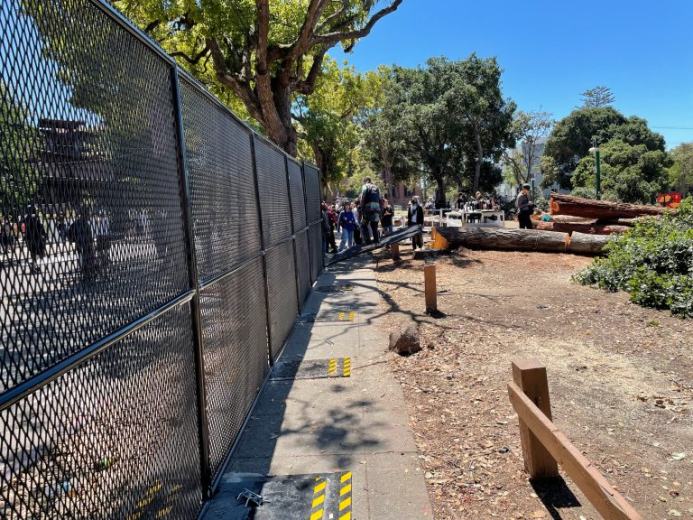August 2022
Statements on Summer 2022 Attempt to Destroy the Park

Response to Chancellor Christ
In the dead of night, UC moved on the park — barricading city streets, blocking access to sidewalks, and fencing the park. Protected by riot police, heavy equipment was brought in. Peaceful protesters sat in front of that equipment to keep the park open and prevent further deforestation of the trees, which UC last did in 2018. People peacefully demonstrated against the heavy machinery and destruction of the trees. They had already witnessed the changing climate in the park after much of the east side forest was demolished by UC just a few years before. Students — of UC Berkeley, local colleges, and high schools — and other community members, including Berkeley neighbors and former residents of the park were outraged by the violent closure and destruction of this community resource.
The university has presented the project as an all-or-nothing: either people will sleep in squalid conditions on the street, or they will build housing on the park. This is a false dichotomy. The park is a vibrant community center, park and recreation space — one of the few accessible and open to everybody, including the poor who suffer within a rapidly gentrifying East Bay. Hundreds of people use the park daily, gathering to play basketball or music, to share food, and community. None of these resources are preserved in the university’s plans, which would turn our park into a sterile dorm lawn. Maximo Martinez Commons is a courtyard just one block north and similar to the one proposed for People’s Park. When was the last time you or your friends used that space?
We need People’s Park to remain a community-run, user-developed and user-defined park. That is why dozens of community groups — such as the Berkeley Student Cooperative, the largest non-profit provider of affordable student housing in the city — stand with People’s Park in opposition to the university’s plans. Homeless advocacy groups such as Consider The Homeless, Berkeley Outreach Coalition, Suitcase Clinic, Berkeley Free Clinic, Berkeley Copwatch, and others stand in solidarity with the park defense.
The UC Regents actually refused Capital Strategies’ attempt to have a $53 million contingency fund available for crowd control, and unforeseen relocations of new residents, and other circumstances in the demolition of People’s Park. Those millions could instead be spent acquiring land for supportive housing sites right in Berkeley, or adding additional housing on a site recommended by the Chancellor’s Housing Commission. And what about the Ellsworth garage, equally close to campus, which has to be demolished due to earthquake danger? In their survey not long ago, 92% of undergraduates did not rank People’s Park as their top site for housing development. If building housing was the university’s top priority, they could have already begun construction on a different site equally close to campus.
Over decades, the UC has approached the park with malice and destructive intent. In spite of this, people have stewarded the land and grown more gardens, community, and lifelong relationships. For 53 years, every time the fences have gone up, they’ve come down! People’s Park is not just some empty real estate lot. People’s Park remains a user-developed park, open for everyone to gather, host events, or hang out and have lunch. Nothing has changed. Come out and see for yourself. We will rebuild once again. Help repair the park according to your own desires. Re-connect with the land!
— People’s Park Council (originally published on PeoplesPark.org)
Statement of the Berkeley Faculty Association
Images of police officers clearing and enclosing People’s Park on 4th August for the construction of student housing had uncanny echoes of Ronald Reagan’s use of state violence to try to reclaim the park as university property in 1969.

“All of this is a far cry from the original vision of a state-supported public university, let alone the radical ambition of People’s Park … The founders of People’s Park took the claim of the university as a public space seriously. They envisioned People’s Park as a truly public space that could not be bought or sold, a commons that could not be enclosed by the campus, whether for athletic facilities–the initial plan–or for student housing. It was the audacity of that vision that led Reagan to try and close the park down. Fifty years later, it appears that enclosure has finally been enacted–by a campus claiming the enclosure is necessary to support its public mission.”
